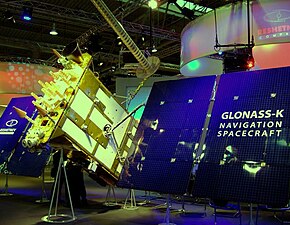
GLONASS is a Russian satellite navigation system operating as part of a radionavigation-satellite service. It provides an alternative to Global Positioning System (GPS) and is the second navigational system in operation with global coverage and of comparable precision.
Meridian 1, also known as Meridian No.11L, was a Russian communications satellite. It was the first satellite to be launched as part of the Meridian system to replace the older Molniya series.

Soyuz-2 is a modernised version of the Soviet Soyuz rocket. In its basic form, it is a three-stage launch vehicle for placing payloads into low Earth orbit. Compared to the previous versions of the Soyuz, the first-stage boosters and two core stages feature uprated engines with improved injection systems. Digital flight control and telemetry systems allow the rocket to be launched from a fixed launch platform, whereas the launch platforms for earlier Soyuz rockets had to be rotated as the rocket could not perform a roll to change its heading in flight.
Meridian 2, also known as Meridian No.12L, was a Russian communications satellite. It was the second satellite of the Meridian system, which replaced the older Molniya series. It followed on from Meridian 1, which was launched in December 2006.

GLONASS-M, also known as Uragan-M are the second generation of Uragan satellite design used as part of the Russian GLONASS radio-based satellite navigation system. Developed by ISS Reshetnev, it had its debut launch in 2003, and is in the process of being phased out. Its production finished in 2015 and its last launch was in November 2022. It is an evolution of the previous Uragan second-generation satellites, improving accuracy, increasing power, extending the design life and adding the FDMA L2OF open signal. The last eight Glonass-M spacecraft in production included the new CDMA L3OC open signal.

The satellite navigation system GLONASS was conceived in the late 1960s, and formal requirements were completed in 1970. The government of the Soviet Union made a decision to develop the system in 1976. Design work was carried out by specialists led by Vladimir Cheremisin at NPO PM in Krasnoyarsk-26. The first launch took place in 1982. Until its dissolution in 1991, the Soviet Union launched 43 GLONASS-related satellites. Work on the system was continued by the Russian Federation which brought it its full operational capability in 1995. In the following years, the system fell into disrepair due to the economic crisis in the country and diminished space funding. Starting from 2000, the government under President Vladimir Putin made the restoration of GLONASS a top priority; its funding was doubled and after a lull of several years, launches were restarted again. In 2003, a new satellite design, GLONASS-M, was introduced. By early 2011, GLONASS had 22 operational satellites, two short of the required constellation of 24 to provide global coverage. The latest and significantly improved satellite type, GLONASS-K, was launched in February 2011.
Kosmos 2471, also known as Glonass-K1 No. 11L or Glonass-K No. 701, was a Russian navigation satellite which was launched in 2011. The first Glonass-K satellite to be launched, it was one of two Glonass-K1 spacecraft which served as prototypes for the operational Glonass-K2 spacecraft.
Kosmos 2478 is a Russian military satellite launched in 2011 as part of the GLONASS satellite navigation system.
Kosmos 2474 is a Russian military satellite launched in 2011 as part of the GLONASS satellite navigation system.
Meridian 6, also known as Meridian No.16L, is a Russian military communications satellite, one of the Meridian series. It is designed to carry military communications traffic and is a replacement for the Molniya satellites. In common with the earlier satellites these craft are in molniya orbits, a highly elliptical orbit named after the earlier satellites and giving good coverage of northern Russia.

Kosmos 2485 is a Russian military satellite launched in 2013 as part of the GLONASS satellite navigation system.

Kosmos 2494 is a Russian military satellite launched in 2014 as part of the GLONASS satellite navigation system.

Kosmos 2500 is a Russian military satellite launched in 2014 as part of the GLONASS satellite navigation system. It was the 2,500th satellite to receive a Kosmos designation

Kosmos 2501, also known as Glonass-K1 No.12L is a Russian navigation satellite which was launched in 2014. The second Glonass-K satellite to be launched, it is the second of two Glonass-K1 spacecraft which will serve as prototypes for the operational Glonass-K2 spacecraft.
GLONASS-K2 is the next-generation satellite design intended to support the Russian GLONASS radio-based satellite navigation system. Developed by ISS Reshetnev, the first satellite was successfully launched on 7 August 2023 from the Plesetsk Cosmodrome with an expected production period of ten years. It is an evolution of the previous GLONASS-K third-generation satellites, adding CDMA signals, improving accuracy and increasing power. It is 70% heavier and has 170% more power.

Kosmos 2514 is a Russian military satellite launched in 2016 as part of the GLONASS satellite navigation system.

Kosmos 2516 is a Russian military satellite launched in 2016 as part of the GLONASS satellite navigation system.

Kosmos 2522 is a Russian military satellite launched in 2017 as part of the GLONASS satellite navigation system.

Kosmos 2527 is a Russian military satellite launched in 2018 as part of the GLONASS satellite navigation system.

Kosmos 2529 is a Russian military satellite launched in 2018 as part of the GLONASS satellite navigation system.








